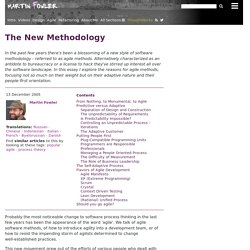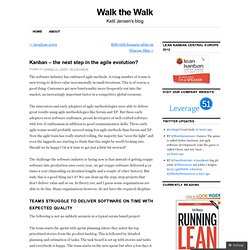

The New Methodology. In the past few years there's been a blossoming of a new style of software methodology - referred to as agile methods.

Alternatively characterized as an antidote to bureaucracy or a license to hack they've stirred up interest all over the software landscape. In this essay I explore the reasons for agile methods, focusing not so much on their weight but on their adaptive nature and their people-first orientation. Probably the most noticeable change to software process thinking in the last few years has been the appearance of the word 'agile'. We talk of agile software methods, of how to introduce agility into a development team, or of how to resist the impending storm of agilists determined to change well-established practices. Zeroturnaround.com » Release Management for Enterprises.
Adopting DevOps Within Your Enterprise Stuck Between a Rock and a Hard Place In a mature enterprise, the development and maintenance of software systems and products rely on processes that have grown over the years.

These process can be fairly detailed, manual and rigid, but the fact is they work! DevOps preaches collaboration and continuous improvement to better meet business goals. Often, continuous improvement means changing culture, processes and automating tasks where possible. The business continues to push IT teams to deliver software and keep up with market needs, while expecting stability and consistent service at the best price possible.
Your (Suggested) Plan of Action. The Politics of Cryptography: Bitcoin and The Ordering Machines. Quinn DuPont It was April 10th, 2013 and the price of a single Bitcoin surged past 250 USD on the Mt.

Gox exchange.i A few months prior I had purchased seven Bitcoins for just under $200, and now they were nearing $2000 in value (Figure 1).ii But, just as fast as the market went up, it came down. Ever the amateur gambler, I panicked and sold too early. But, I was lulled by my humming money machine, permuting cryptographic codes by the millions every second. Metcalfe's Law is Wrong. The increasing value of a network as its size increases certainly lies somewhere between linear and exponential growth [see diagram, " "].

The value of a broadcast network is believed to grow linearly; it's a relationship called Sarnoff's Law, named for the pioneering RCA television executive and entrepreneur David Sarnoff. At the other extreme, exponential--that is, 2n--growth, has been called Reed's Law, in honor of computer networking and software pioneer David P. Reed. Reed proposed that the value of networks that allow the formation of groups, such as AOL's chat rooms or Yahoo's mailing lists, grows proportionally with 2n. Beyond Budgeting Institute – From Command & Control to Empower & Adapt. Optional+scope+contracts. Scrum Patterns by Jim Coplien - Scrum Inc. Test Driven Development (TDD): Best Practices Using Java Examples. In the previous article Test Driven Development (TDD): Example Walkthrough an example of TDD was given.

It went from writing first test and its implementation to having a set of requirements fully tested and developed. Now it’s time to learn what the best TDD practices are. This article will be built on examples from the previous one. Best practices are solutions to a set of problems under certain situations. Not following them would make us “reinvent the wheel” and struggle with the same problems already solved by others. Some of the best practices described here are inherited from other sets of practices and used when doing TDD. Source code for all examples can be found in the github repository Implementation is in the source directory src/main/java and tests can be found in src/test/java. Before explaining best practices, it is important to understand the TDD life-cycle. Test-driven development is not about testing. Practices have been separated into following categories: Processes.
No Projects - Beyond Projects. The Problem with Projects and some ideas on what to do about it Applying the project lifecycle model to software development complicates both and makes developing good software harder.

Using the language, terminology and mindset of projects to discuss something that is inherently not a project creates conflict, confusion, short-termism and sets inconsistent goals. Controlling these conflicts requires manager intervention. The two models conflict and increasingly create problems. Visualize your Work and Workflow. Kanban – the next step in the agile evolution? The software industry has embraced agile methods.

A rising number of teams is now trying to deliver value incrementally in small iterations. This is of course a good thing. Customers get new functionality more frequently out into the market, an increasingly important factor in a competitive global economy. The innovators and early adopters of agile methodologies were able to deliver great results using agile methodologies like Scrum and XP. But these early adopters were software craftsmen, proud developers of well-crafted software with lots of enthusiasm in addition to good communication skills. Teams struggle to deliver software on time with expected quality The following is not an unlikely scenario in a typical scrum based project: The team starts the sprint with sprint planning where they select the top prioritized stories from the product backlog.
Kanban_board_1.png (904×621) 20120304-223048.jpg (960×479)